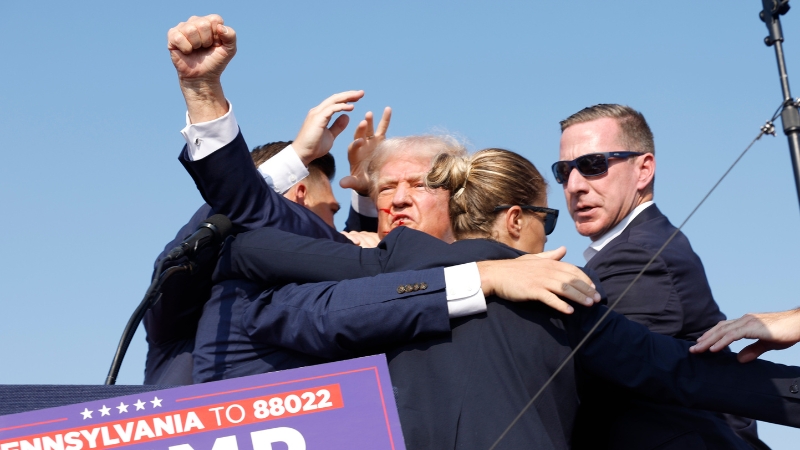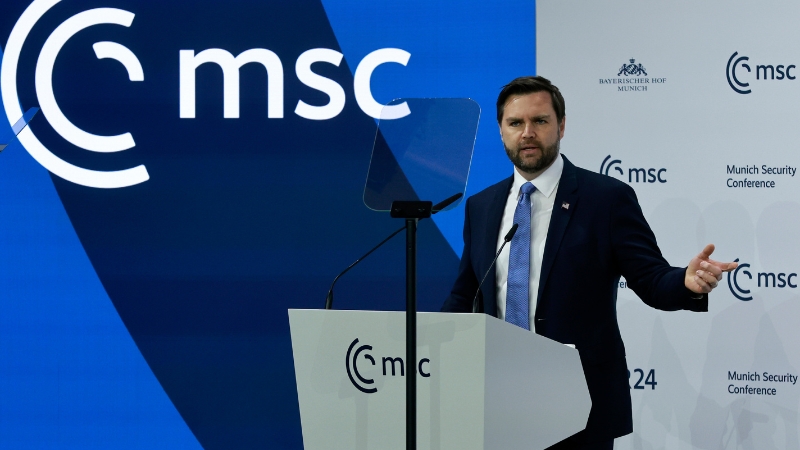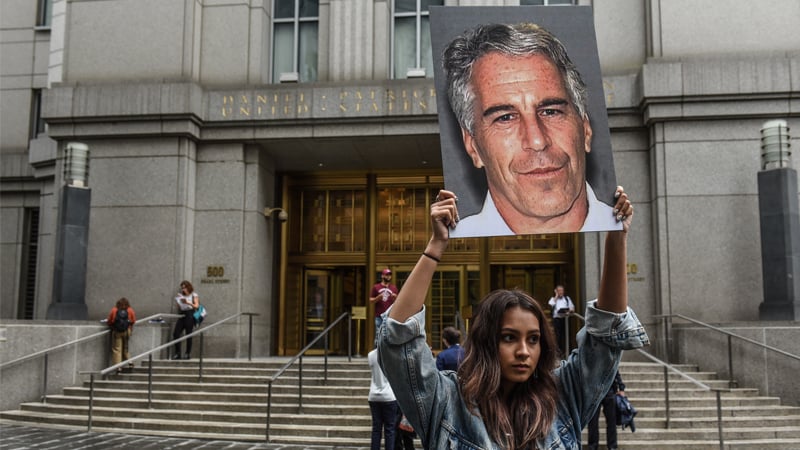 Image Credit: Anna Moneymaker / Staff / Getty Images
Image Credit: Anna Moneymaker / Staff / Getty Images A turn of the head: that was all it took to change history.
Tomorrow is the one-year anniversary of the first attempt on Donald Trump’s life, when the coward Thomas Matthew Crooks came within millimeters of exploding the President’s head live on television, three months before the election.
Instead, Trump turned his head just a fraction to the right—to look at a chart of immigration statistics, would you believe—and a bullet that would have entered his temple grazed his ear and he didn’t die.
The President dived to the ground, and was covered by a dense mass of Secret Service agents.
As he returned to his feet and composed himself, he told the agents to wait. He knew, instinctively, there was something he had to do. He had to show the world—even if the shooter was still at large—that he was not afraid, that violence would not be enough to stop him or the American people from reclaiming their birthright.
Bloodied but defiant, Trump raised his fist and mouthed, “FIGHT! FIGHT! FIGHT!” The crowd, deadly silent after the initial shock and confusion, erupted. “USA! USA! USA!” they began to chant.
Only then could Donald Trump leave the stage.
Watching that moment again now, I still find it hard to believe. But it really did happen.
The Miracle at Butler is proof of many things, not least of all the fact that there is a Donald Trump who represents such a threat to the existing order—to the America Last status quo—that no option is off the table to prevent him from achieving his goals.
No option: not even murder.
Not even now.
It was clear to me, as early as the autumn of 2023, that Trump’s opponents would try to kill him. I claim no unusual foresight, no gift of prophecy. I was just paying attention to what the people who hated Trump the most and were the closest to the real levers of power were saying. People like Robert Kagan, for example, the husband of the despicable Victoria Nuland. Kagan made it very clear, in the pages of The Washington Post, that Trump was on course to be America’s Caesar—unless of course some American Brutus were to come along and save the Republic before it could be destroyed.
I called this framing of the Trump menace, and the desperate means to stop it, “the Brutus Option.”
I wasn’t the only person who saw it. Other people did too. Tucker Carlson, for one. What else could Trump’s opponents do, Tucker asked, if the non-stop slander and the legal cases and the persecution and all the political gerrymandering didn’t work? How else could Trump be stopped?
Death, that’s how.
So what of that Trump, the radical Trump they had to kill—or try to kill—to stop? Where is he now, one year later and nearly six months into his second term as president? Is that Trump still alive?
The short answer is yes. Radical Trump is still alive and he’s still in the White House. But that doesn’t mean we can afford to be complacent or to have blind faith in him.
There have been notable disappointments and failures since Trump took office. We have to be honest about this. The Ukraine war still rumbles on, despite Trump’s election promise to end it within 24 hours of taking office. In fact, the war may have become more not less dangerous as a result of Trump’s return. The threat to end the war appears to have emboldened Ukraine and its supporters to take even riskier chances to prolong the fighting. Ukraine recently struck Russia’s nuclear deterrent deep inside Siberia, in an attack that thankfully didn’t but easily could have triggered World War III.
World War III. That was also a prospect raised by the recent strikes on Iran’s nuclear facilities, first by Israel and then the US itself, with its B2 stealth bombers and massive bunker-buster bombs that nobody else has. Mercifully, the long-threatened threatened war with Iran didn’t materialise—there were no ground troops or further strikes—and Iran’s own response was minimal and telegraphed to avoid any chance of killing American personnel. But even if the destruction of Iran’s nuclear capabilities helps bring lasting peace to the Middle East and disarms a dangerous adversary—even if things turn out exactly as 4D chessmaster Trump planned—many have been left with the lasting impression that it’s Israel that really calls the shots when it comes to America’s foreign policy. And that’s not good, especially when another Middle East crisis rolls around, as of course it will. Who’ll be in charge then?
What else? The Epstein disclosures: What a horrible mess they’re turning out to be. We shouldn’t underestimate the anger the obvious lies and obfuscations are causing among the MAGA base, even if we don’t know the exact causes, the who and the why. Nobody believes Epstein was just some pervert who had a few rich friends and then decided to kill himself when his crimes caught up with him.
Then we have the breach between the President and Elon Musk, after he stepped aside from leading the Department of Government Efficiency. This rift threatens to tear apart the fragile MAGA-tech alliance; although it could just as easily prove to be a great big nothingburger and the two men could be reconciled. Then again, if Elon with all his billions really can create a third party out of thin air—his America Party—it could split the MAGA vote in dangerous ways and gift victories in the midterms and in 2028 to the Democrats. Who knows?
There are other disappointments too. I see the first signs of a MAHA climbdown on the regulation of harmful chemicals, for example, and I don’t like it. You have other annoyances and niggles, I’m sure.
But all of this must be balanced against one fundamental truth: That the original cause of MAGA, its raison d’être—immigration restriction and reversing demographic change—is still on track. National revival, which means saving America from the catastrophic effects of decades of mass immigration, is still possible.
Trump’s Big Beautiful Bill is far from perfect, but it provides close to $170 billion for immigration-related causes, including $75 billion for Immigration and Customs Enforcement, making it better funded than 189 of the world’s national militaries. The agency can now expand its detention capabilities by as many as 100,000 beds and hire tens of thousands of new agents and pay for raids across the length and breadth of the nation. Deportation can become the war machine it must become if 20 million illegals are to be removed.
There’s also $45 billion to build the border wall, the central symbol of the MAGA movement since Trump came down that golden escalator a decade ago.
I said earlier now is no time for complacency. Even after this enormous victory, which has handed Trump a “deportation machine on steroids,” patriots must guard against calls for amnesties or all-but-amnesties for illegals working on farms and in restaurants and hotels. The MAGA base must insist, as Steve Bannon has urged, that no exceptions be made. Twenty million means 20 million. No ifs. No buts.
Trump’s opponents on the left still remain a threat, including a growing lunatic fringe who are embracing violence as the only way to achieve meaningful change, but at this point, as far as I can see, the most significant danger to Trump remains Trump. Trump the dealmaker, in particular. In certain situations, of course, compromise is essential, as the President knows only too well. But now, when it comes to his central promise to the American people—that he would give them back their country and with it a glorious future to match the glorious past—there can be no compromise.
As he reflects tomorrow on what could have been, on the fact that fate and destiny are decided by a hair’s breadth or less, I hope President Trump will remember that promise he made and feel a renewed sense of purpose, of God-given mission. There’s still so much to be done, and he is still the man to do it.


